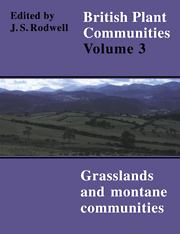Book contents
- Frontmatter
- Contents
- List of Figures
- Preface and Acknowledgements
- Preamble
- Mesotrophic Grasslands
- Community Descriptions
- Calcicolous Grasslands
- Community Descriptions
- Calcifugous Grasslands and Montane Communities
- Community Descriptions
- Index of Synonyms to Grasslands and Montane Communities
- Index of Species in Grasslands and Montane Communities
- Bibliography
MG2 - Arrhenatherum Elatius-Filipendula Ulmaria Tall-Herb Grassland Filipendulo-Arrhenatheretum Elatioris Shimwell 1968a
Published online by Cambridge University Press: 04 July 2020
- Frontmatter
- Contents
- List of Figures
- Preface and Acknowledgements
- Preamble
- Mesotrophic Grasslands
- Community Descriptions
- Calcicolous Grasslands
- Community Descriptions
- Calcifugous Grasslands and Montane Communities
- Community Descriptions
- Index of Synonyms to Grasslands and Montane Communities
- Index of Species in Grasslands and Montane Communities
- Bibliography
Summary
Synonymy
Polemonium caeruleum stands Pigott 1958; Tall-herb grassland Grime & Blythe 1969; Habitat Study 51 Elkingkton 1969; Species-rich Arrhenatherum grassland Bb Lloyd 1972.
Constant species
Angelica sylvestris, Arrhenatherum elatius, Cruciata laevipes, Dactylis glomerata, Dryopteris filix-mas, Epilobium montanum, Festuca rubra, Filipendula ulmaria, Geum rivale, Heracleum sphondylium, Mercurialisperennis, Poa trivialis, Silene dioica, Urtica dioica, Valeriana officinalis, Eurhynchium swartzii, Plagiomnium undulatum, Plagiothecium denticulatum, Lophocolea bidentata s.l.
Rare species
Polemonium caeruleum.
Physiognomy
The Filipendulo-Arrhenatheretum is a luxuriant vegetation type dominated by large tussock grasses, notably Arrhenatherum elatius and Festuca rubra with smaller amounts of Dactylis glomerata, and tall hemicryptophyte dicotyledons, especially Filipendula ulmaria with some Heracleum sphondylium, Urtica dioica, Valeriana officinalis and Angelica sylvestris. These form an uneven canopy which may be more than 1 m high and beneath them is a thick understorey of shorter species of which Mercurialis perennis, Geum rivale, Cruciata laevipes, Epilobium montanum, Silene dioica, Poa trivialis and Dryopterisfilix-mas are the most conspicuous. Frequent associates, some of which may attain local abundance, are Trisetum flavescens, Veronica chamaedrys, Vicia sepium, Rumex acetosa, Hypericum hirsutum, Campanula rotundifolia, Scrophularia nodosa, Anthriscus sylvestris and Saxifraga hypnoides. There is a marked seasonality in the vegetation with rapid early summer growth of the dicotyledons and complete winter die-back.
Bryophytes are always present and may form a lush, varied and extensive ground cover. The most frequent species are Plagiothecium denticulatum, Eurhynchium swartzii, Plagiomnium undulatum, P. affine, Calliergon cuspidatum, Brachythecium rutabulum, Rhytidiadelphus squarrosus, Hylocomium splendens and Lophocolea bidentata s.l.
Numerous other flowering plants and bryophytes occur at low frequency to make this one of the richest mesotrophic grasslands. There may also be occasional records for saplings of Fraxinus excelsior, Ulmus glabra, Prunus padus and Corylus avellana which reflect the frequent spatial association of the community with open or fragmentary woodland. The disposition of the vegetation over steep rocky slopes and ledges may introduce an additional element of physiognomic complexity.
Sub-communities
A provisional distinction is made here between two subcommunities, based partly on the presence or absence of the national rarity Polemonium caeruleum. The samples with P. caereuleum are numerous but from a relatively small number of sites (Pigott 1958, Shimwell 1968a, b) and some of their distinctiveness may be related to deliberate selection of stands and a more thorough searching of the vegetation, especially for the smaller bryophytes.
- Type
- Chapter
- Information
- British Plant Communities , pp. 43 - 48Publisher: Cambridge University PressPrint publication year: 1992

